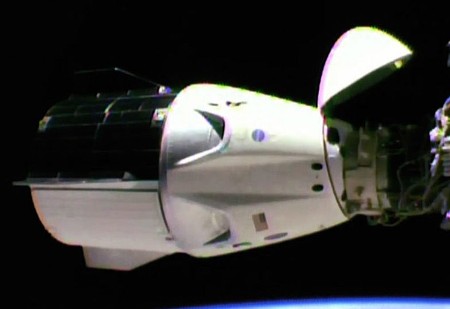June 17, 2020 – NASA has expressed confidence in SpaceX reusability for both the Falcon 9 first stage and for the Crew Dragon spacecraft. Originally the plan was to use a new rocket and capsule for each mission to the International Space Station (ISS). But the performance of the Demo-2 mission has produced a level of confidence in the technology to begin to take advantage of the savings that will be derived from the reuse of much of the rocket. Only the second stage for these missions will be a throw-away.
In a second announcement, NASA extended the stay of the astronauts who flew to the ISS on Crew Dragon from two weeks to as much as 119 days. Crew Dragon will remain attached to ISS throughout the astronauts’ extended stay and will be further evaluated while mated to the station.
Originally, SpaceX intended to reuse Crew Dragon capsules for non-NASA crewed flights beginning as early as next year. These would be private flights for commercial customers. But now it appears that NASA will hog the show with Crew Dragons becoming the primary space taxi for American astronauts. SpaceX believes that the existing design sill have a shelf life of six missions before major refits or retirement. That would be a remarkable achievement in reusability considering the challenging environment of space and atmospheric re-entry.
Falcon 9 first stages have been reflown as many as five times by SpaceX for a variety of missions, but not for human crews until earlier this month. The current Falcon 9 which will eventually be replaced by the SpaceX Starship, has been designed to withstand launch and return for as many as ten missions. Starship, on the other hand, will be designed for 100% reusability.
Why is it that the first stage can manage up to ten missions while Crew Dragon is rated for six? The answer is in the re-entry which for the latter puts much more stress on the vehicle. You’ll get to see exactly how much when Crew Dragon returns in three months or so from the Demo-2 Mission.
Falcon 9’s return is comparatively a piece of cake. The first stage as it falls back into the atmosphere begins a reentry burn which slows it down and ensures it is oriented to produce minimum stress on the rocket during descent. Stabilizing fins deploy to maintain the rocket’s orientation and increase drag. At the end, the Falcon 9 does a speed-slowing landing burn and deploys retractable legs before touchdown.
Crew Dragon missions for the moment land on water just like in the days of Apollo. Crew Dragon, however, has something Apollo never had, onboard rockets which in the future could be used for soft landings on hard surfaces.
A new Crew Dragon spacecraft is expected to be on top of a Falcon 9 in late August for the next crewed mission to the ISS. Modified Crew Dragons will take over the supply missions to the ISS with almost double the payload capacity of the original Dragon capsule.
Of course, SpaceX has considered how to achieve 100% reusability with its current Falcon rockets. It has started to capture the space farings that sit atop the second stage to protect satellites during launches. It has even toyed with bringing the second stage back to Earth for a soft landing. But to do this SpaceX would have to redesign the stage to give it similar attributes to Falcon 9’s first stage. The company briefly considered a demo smaller-scale Starship could replace the second stage and be used to ferry crews and deploy satellites into near-Earth orbit. But that idea has been shelved as the company has continued to perfect Dragon, and to build test versions of the future Starship.









